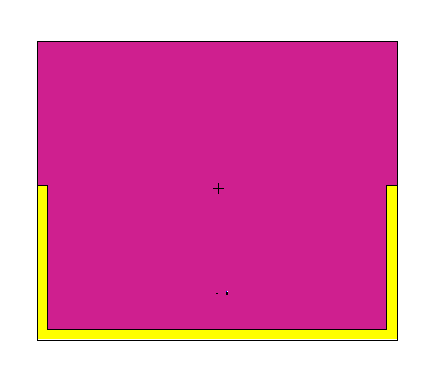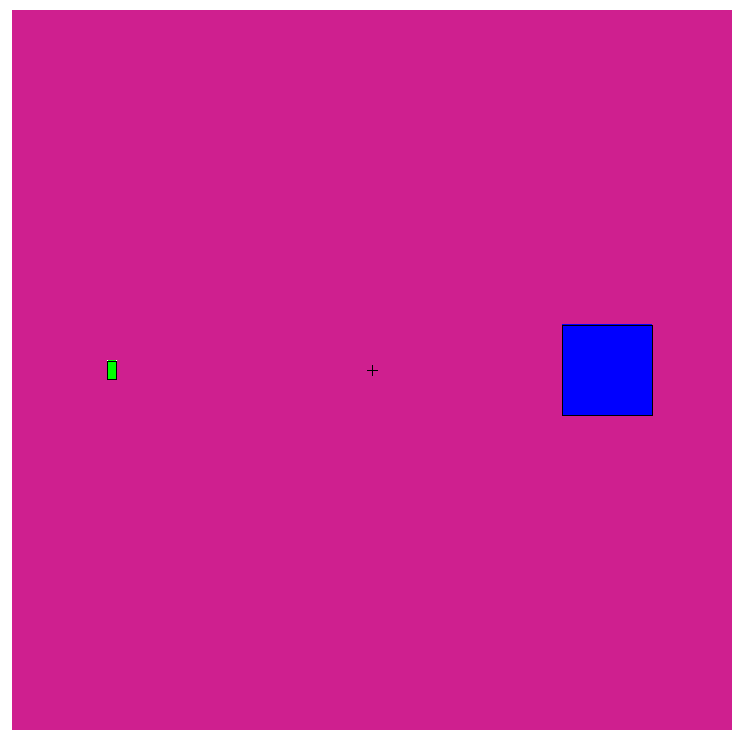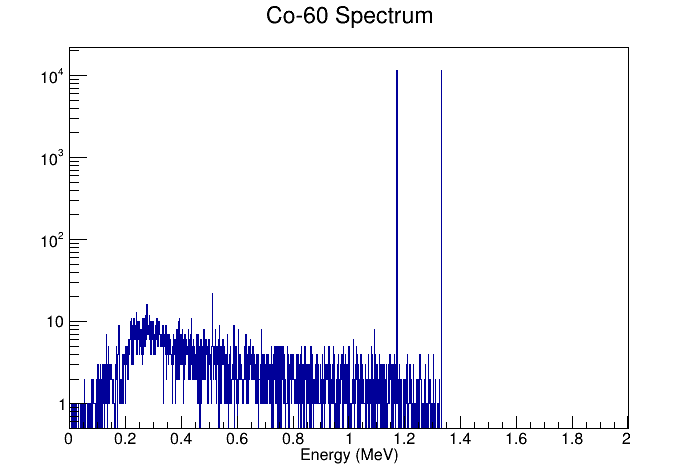Co-60 source and Ge crystal inside a concrete room
In this MCNP simulation, a Co-60 source and a Ge crystal are inside a concrete room. The Co-60 source is finite in size; a small cylinder, 10 mm in diameter and 5 mm deep. The Ge crystal is also contained in a cylinder (5 cm diameter, 5 cm deep), whose axis coincides with the Co-60 source's axis. The center of the sources is exactly 25 cm from the front face of the Ge crystal. The axes of both the source and the Ge crystal are at a height of 1 m above the concrete floor. The problem is 10 x 10 x 10 m3 in size and the concrete room consists of a 10 x 10 m2 floor and 5 m tall walls. All concrete structures are 30 cm in thickness. The geometry of the problem is identical to Cf-252 Watt neutron source and NE-213 scintillator inside a concrete room.
This simulation does not have tallies. Instead, events entering the front-face of the Ge crystal are saved to file (PTRAC). The optional software ptrac2root can be used to convert PTRAC events to a ROOT TTree data structure.
The input file (co60) of this MCNP simulation is well documented with comments, and is meant to be modified or augmented with other structures if desired.
Demo
The following picture shows the simulation geometry (from the MCNP plotting utility),

The cyan color represents air, and the yellow the concrete floor and walls. Barely visible, above the floor, is the source and crystal. The following fade-in picture shows the geometry of the Co-60 source (green) and Ge crystal (blue), viewed from the side,

Not clearly seen, the structures are two cylinders facing each other.
Running MCNP with 10,000,000 events yields the following spectrum of photons entering the face of the Ge crystal,

The Co-60 lines at 1.173 and 1.332 MeV dominate the spectrum. The broad lower-energy distribution are scattered gamma rays. This spectrum has been generated with the optional software ptrac2root.
Execution
This MCNP input has been developed and tested using MCNP version 5. The geometry of the problem can be viewed with the command,
whereas the simulation itself is executed with the command,
Output
The output of the simulation is a PTRAC file in ASCII format. This file can be converted to a ROOT TTree data structure with ptrac2root. Included is the ROOT file (co60.root) containing the gamma energy spectrum histogram from the simulation shown above. The histogram is made by ptrac2root. The gamma energy spectrum histogram can be retrieved and displayed by executing the spectrum.C script included,
root [0] .L spectrum.C
root [1] plot()
Dependencies
The MCNP code is export controlled and distributed worldwide through RSICC. Users must register to obtain a copy of MCNP.
Current version of ROOT can be downloaded and installed in most Linux distributions. In Debian-based systems, the tutorial "Installing CERN ROOT on Debian GNU/Linux 13 (trixie)" may be of use.
List of Files
Included in this software package are the following files:
- co60 (MCNP input file)
- co60.root (ROOT file with spectrum histogram)
- spectrum.C (ROOT script to display the neutron spectrum histogram)
- README (documentation)
- terms.md (terms of use)
- license.md (license)
Terms of Use and License
Before buying, please read our Terms of Use and License.